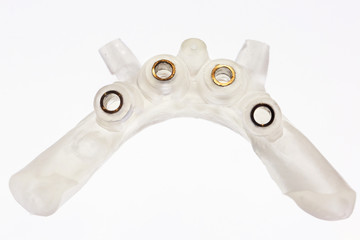Dental implants have a history of research and development spanning over forty years. This extended period has helped us better understand the characteristics required for implant placement to ensure the best possible prognosis over time. A key factor in this history is the prosthetically correct placement of implants. This means placing them in a way that achieves the potential for a biologically proper prosthetic restoration.
An essential aid in successful placement is the surgical guide.
The surgical guide is designed and manufactured in our clinic with the help of three technologically advanced tools in our equipment.
These are:
- The intraoral scanner, which scans and digitally captures the exact condition of the teeth and soft tissues of our patient’s mouth.
- The CT scanner, which provides us with the ability to obtain a three-dimensional radiographic image of the jaw.
- The software that allows us to connect the two diagnostic elements mentioned above.
This specialized software allows us to virtually place and design the most correct – both prosthetically and biologically – position for our implants on our computer screen.
The design file is then sent to the 3D printer, which will print the surgical guide.
One of the main advantages of the surgical guide is its increased accuracy. This not only reduces the duration of the surgery but also minimizes trauma, pain, and swelling. This translates to a reduced recovery time for our patients.
Additionally, the ideal placement of the implants results in the ability to create a functionally and aesthetically perfect prosthetic restoration.


